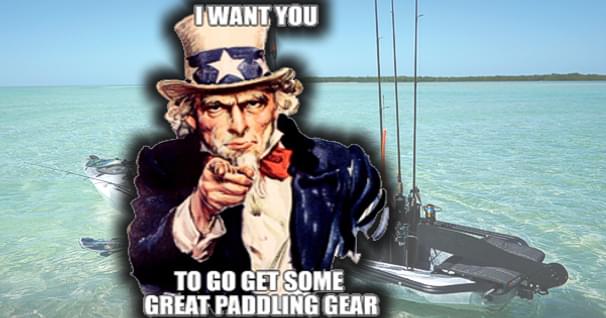Lift, Carry and Load your own Kayak!
Lifting, loading and carrying a kayak seems to be one of the biggest concerns women have when they're getting into the sport. One of the first questions that women often ask me is: "Can I carry a kayak by myself? Can I load it onto my car?" Using the right technique it is possible to lift, carry and load your own boat. It may take some practice, but for a lot of women this is a plausible goal. Even if the kayak feels heavy at first and awkward to carry, the more you practice the easier it gets because you'll be building strength and stamina. My advice is to accept that it won't feel easy and natural the first time you try it. Give it some time.
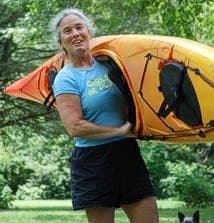
On the other hand, there are women who feel that the boats are too heavy and some women have physical limitations that don't allow them to even attempt to carry a kayak. That's ok because there is quite a bit of technology designed to make lugging your boat around easier. For example, you can get special kayak roof-racks with rollers that make loading boats onto a vehicle manageable for even one person; and kayak carts that work more or less on the same principle as a wheelbarrow to help you get your kayak along the ground and into the water. I'll discuss proper technique for carrying kayaks as well as these different alternatives in this article.
Lifting and Carrying
Kayaks, especially rec and touring kayaks, come in many different sizes and weights, ranging from 40 to 80 lbs (18-36 kg). Kayaks that are designed for purely recreational purposes tend to be smaller and lighter, while touring/sea kayaks tend to be heavier.
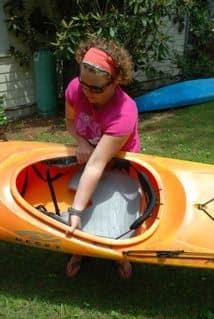
The most efficient way to lift and carry shorter, lighter boats is to pick up the kayak and lift it onto one shoulder. Begin by standing with the kayak on the ground on edge against your shins with the cockpit facing out. Bend your knees and place both hands on the edge of the cockpit closest to your chest. Slide the kayak up onto your thighs while keeping your knees bent. Once the kayak is resting on your thighs take your right hand and grasp the opposite side of the cockpit rim. As you stand up lift the right side of the cockpit rim up and onto your shoulder. Let the rim rest on your shoulder. Position the kayak comfortably on your shoulder so that it feels balanced and you can walk without the boat hitting the ground at either end.
TAHE 10'6 & 11'6 SUP-YAK Inflatables
2-in-1 Kayak & Paddle Board complete packages for single or tandem use.
Here are a few tips to remember when carrying your kayak:
- To protect your back when you lift the kayak, always be sure to bend at your knees and not at your waist.
- If you wear your PFD when you carry your kayak the shoulder strap of the lifejacket will provide cushioning for your shoulder.
- Make sure that when you pick your kayak up the bow is facing forward. This will make it easier to carry.
Some boats are much longer and too heavy or awkward for one person to carry on their shoulder. Sit-on-tops are also trickier to carry because they don't have a cockpit rim that you can rest on your shoulder. One alternative, which also works with shorter boats, is a two-person carry. For this carry, you and a friend each grab one of the toggle or grab-loop hand-holds at the bow and stern of the boat. Be sure to bend your knees and communicate well with each other to synchronize the lifting and putting down, which will not only make everything go more smoothly but will also prevent back injuries!
Dragging
If you have a plastic boat, you can also drag your kayak by holding onto the toggle or grab-loop hand-hold at the bow of the boat. It's not a good idea to drag a composite or fiberglass boat because this can result in expensive damage to their more fragile hulls.
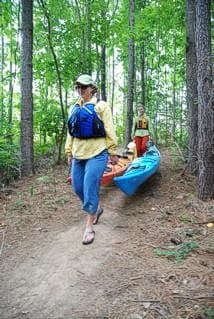
Using a Kayak Cart
Kayak carts are ideal for longer distances between the water and your vehicle. They are a good option if you need to bring your kayak over fairly even ground-meaning most boat launches and grassy shorelines, but are not usually suitable for very rough or rocky put-ins.
Kayak carts are two-wheeled attachments that slide onto one end or the center of your boat so that you can simply wheel your boat along by grabbing a handle at one end. Working on the same basic principles as a wheelbarrow, the result is that you bear very little of the weight yourself. Most kayak carts can be folded or easily assembled and disassembled so that they can be tucked into your boat or one of your hatches while you paddle.
Kayak carts typically cost between $60 and $150. There are also plenty of plans for homemade carts that you can find online if you're feeling a little handy.
Using a Roof Rack
Loading a kayak onto a vehicle can be a bit challenging by yourself, so it's good to have a reliable rack system that makes it simple. There are many different types of racks to choose from, including rack systems that lift the kayak onto the roof for you!
If you have factory racks already installed on your vehicle, you can buy special rack accessories for kayaks that will fit them. If your vehicle doesn't have factory racks, then you'll need to invest in basic towers and cross bars to support the accessories. Basic towers are usually stronger and can support more weight than factory racks, so depending on what roof rack system you want to you use, investing in towers might be a good idea.
J Cradles and Stackers
J-shaped cradles attach to factory roof racks so you don't need towers. The J cradle is designed to hold the boat on its side, which frees up roof space for more storage. J cradles require you to lift your boat over your head to put the kayak in place. To do this, begin by standing with the kayak on the ground on edge against your shins with the cockpit facing out. Bend your knees and grab the front of the cockpit with one hand and the back of the cockpit with the other. Slide the kayak up onto your thighs while keeping your knees bent. Lift one knee up to support the boat, then lift the kayak over your head and place it on the cradles. All that's left to do once it's in the cradle is tie it down.
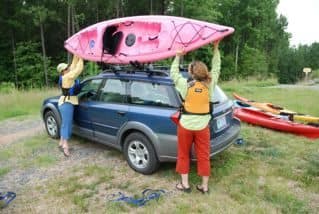
You can also use kayak stackers to stack boats on their sides against one another. This allows you to load more kayaks onto one roof rack than the J Cradles. Stackers are usually used more for whitewater kayaks, but they also work for rec and touring kayaks.
If you can't lift your kayak above your head to load the boats directly onto the cradles ask a friend for help or check out some of the resourceful ideas below.
Other Options
Among the most affordable options are kayak saddles with rollers. Kayak saddles/rollers fit on vehicle rack crossbars and are less expensive than J cradles. You just have to get the bow of the boat into the rollers and then slide the boat forward until it is firmly positioned in the saddle at the front, and then tie the kayak down.
I've heard of women who place a big piece of carpet over the hoods of their cars and slide their kayaks over the carpet and up onto the rack. This is a very resourceful and cheap way to get your kayak up onto your roof racks by yourself without having to lift your boat!
Along the same lines, you can buy two foam "pool noodles" with hollow centers, and then slice them along their length. You can then fit these over the bars of your roof rack and secure the noodles with duct tape. These won't last many seasons, but they can be surprisingly durable and provide a protective base to rest your boat on. Depending on the height and size of your vehicle, you can get one end of your boat up first and then slide it forward before tying it down, or you may have to use the same lifting method as described for the J cradle.
If you know that you'll often be paddling solo, consider getting a lighter boat in the first place, or invest in a more expensive rack system that lifts the boat for you like the Hullavator System by Thule. How cool is it to place your kayak on the rack at waist level, tie it down and then have it lift hydraulically onto your roof!
Don't feel like you have to be able to lift and load your kayak onto your vehicle by yourself to enjoy the sport. Take advantage of the products that are available to help you enjoy all aspects of kayaking. If you are excited about building the strength and stamina it takes to lift, carry and load, be sure to be gentle with yourself and take your time.
Tying Down Your Kayak
The easiest way to secure your boat to your vehicle is to use cam straps that are available from most outfitters or hardware stores. Cam straps save you from having to remember specific knots and are easy for most people to use. The key is to tighten the straps on either side of the widest part of the boat to ensure no forward or backward movement. With plastic boats, you can pull your cam straps as hard as you want. With composite or fiberglass boats, you have to be a little gentler-aim for snug, not tight.
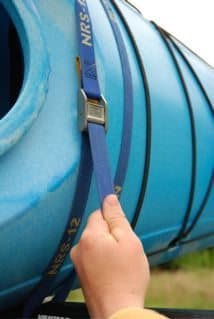
To be extra careful, you can tie a bow and/or stern line from the kayak to the front and/or back bumper of the vehicle. You can just use cam straps, regular ropes, or get specialized, Y-shaped bow and stern tie-downs. If you use a bow or stern line, make sure that you do not pull them too tight, because this can warp the shape of the boat along its length.
If you are using ropes to tie down your boats you'll want to learn how to make and use the proper knots. Because knots are easier to learn when they are shown, not written about, I suggest that you check out the demonstration in the instructional DVD, Kayaking for Women or ask a friend who is good with knots to show you how.
TIPS
Buy and store a little step ladder in your vehicle to make it easier to reach the straps! No matter how well you have tied the boat on, straps and loops can loosen while driving. It is a good idea to check them every so often, especially on longer drives.
As I mentioned before, lifting, carrying and tying down kayaks takes practice so don't give up if you feel awkward at first. Learning these skills will help you feel stronger, more confident and self-sufficient on and off the water.
Anna Levesque is a world-class kayaker who has a passion for inspiring and teaching women. Her experience as an accomplished international competitor, author, instructor and business owner has placed her as the leading expert in her field. Her top accomplishments as a whitewater athlete include a bronze medal at the 2001 World Freestyle Kayak Championships, a spot on the Canadian National Freestyle Team five years in a row, and many top 3 finishes in both Freestyle and Extreme Racing. Anna combines her international expertise in kayaking with her experience as a yoga instructor and student of meditation, to inspire women in confidently creating success and happiness in all aspects of their lives. She offers women's paddling retreats, clinics and trips in Mexico through the her company, Girls at Play, and the Nantahala Outdoor Center. For more information please visit www.watergirlsatplay.com
Related Articles
Need help loading your kayak onto the roof of your vehicle? Austin Kayak and ThatBassFishingDude…
Spring is here and (hopefully) you've got your tax returns completed by now. If you find yourself with a…
For some of us, storing our canoe or kayak is as simple as dropping it off alongside the garage or…
Remember the ‘good old days’ when there were at least two or three places along the front and back of…


